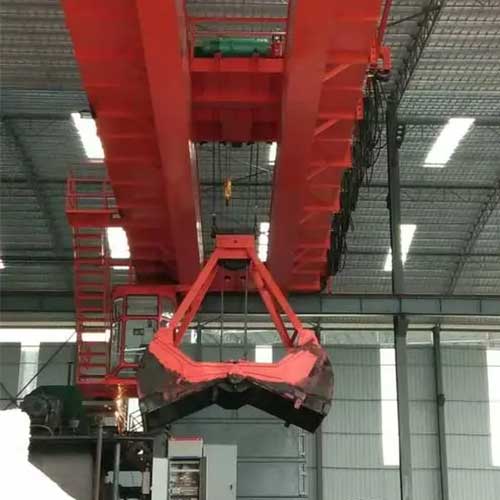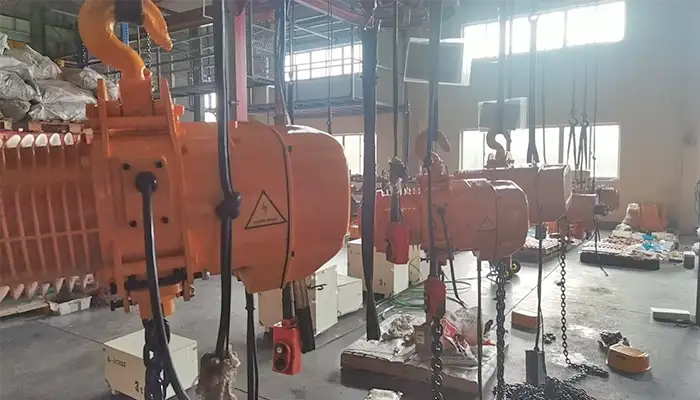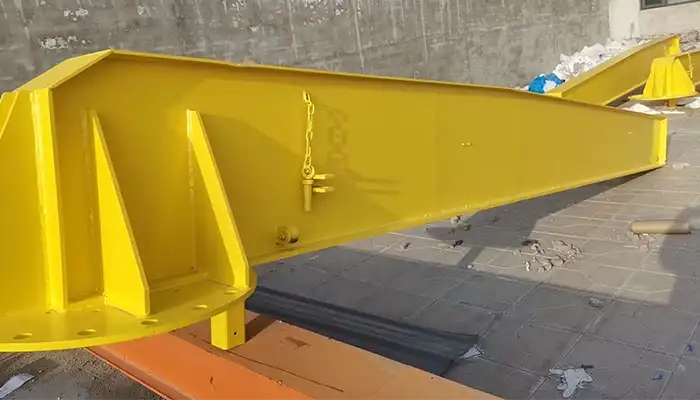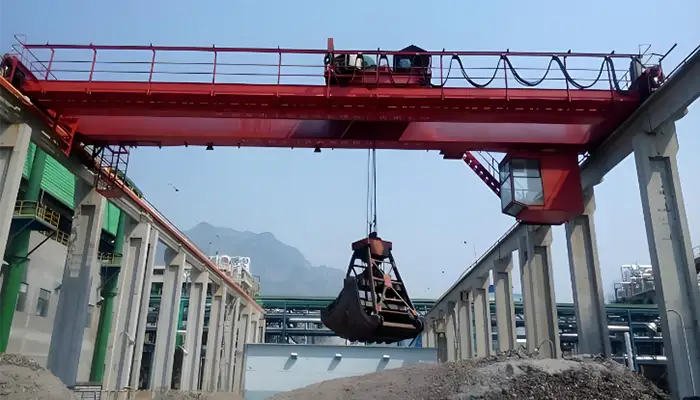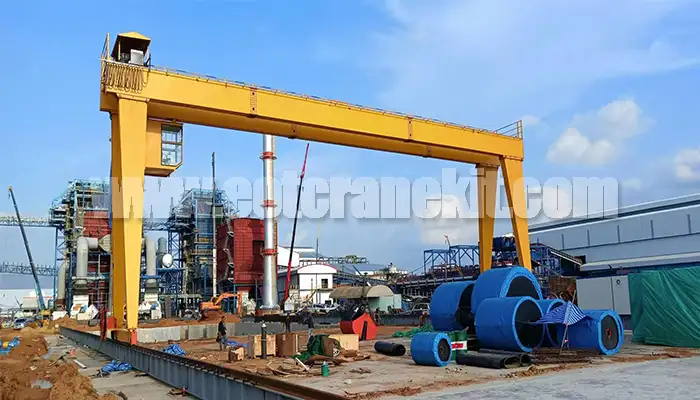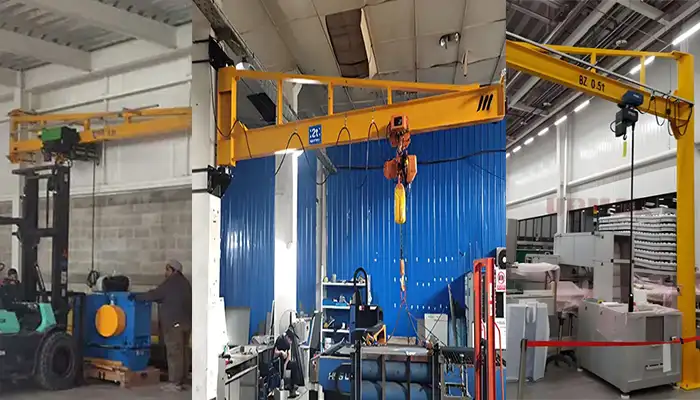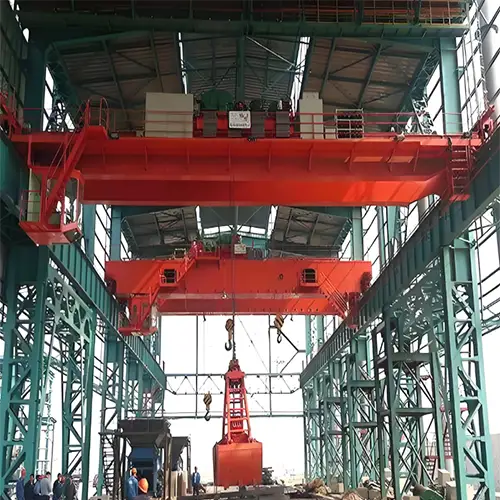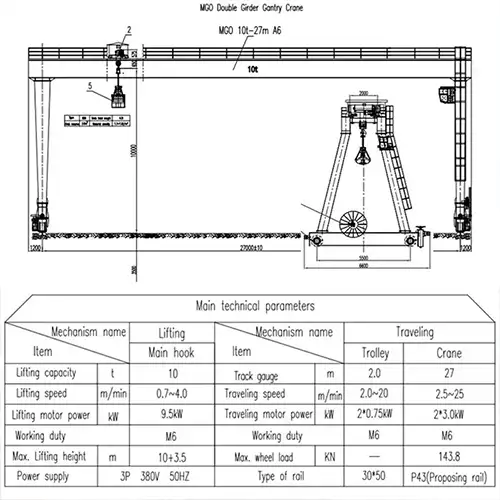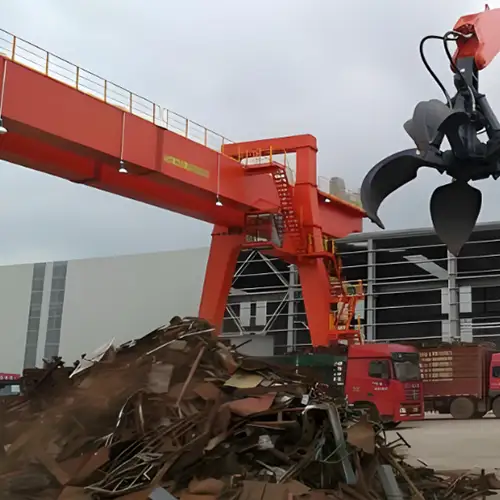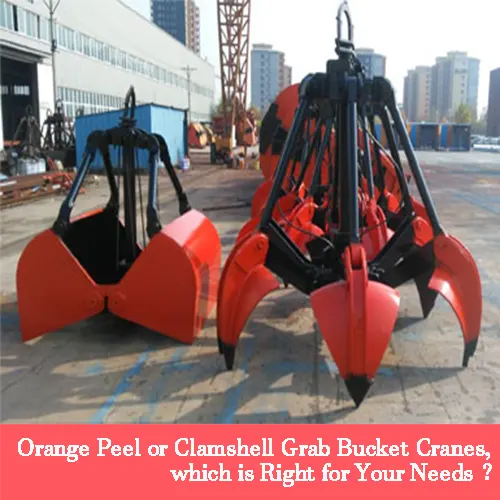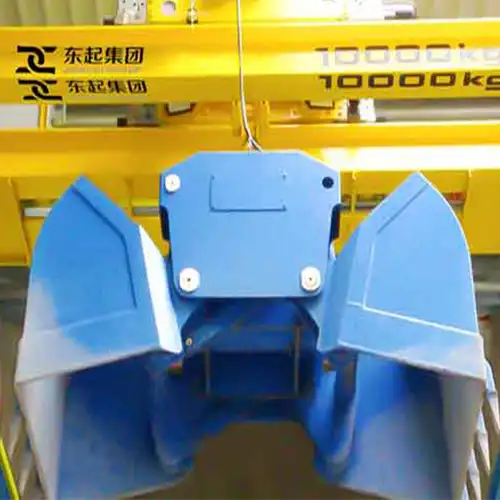Four Rope Grab & Grab Bucket Crane for Sale, Affordable Bridge Cranes
Four rope grab overhead crane & gantry crane for sale. Affordable grab bucket crane for bulk material handling with bridge crane & goliath crane design.
Category: Grab Crane
Your Trusted Overhead Travelling Crane Manufacturer & Supplier
Four Rope Grab & Grab Bucket Crane for Sale, Affordable Bridge Cranes
Clamshell & Orange Peel Four Rope Grab Bucket Overhead Cranes & Gantry Cranes
A four rope grab bucket crane is a type of crane that uses a grab bucket attached to four ropes to lift and transport materials. The grab bucket is designed to open and close, allowing it to pick up loose materials such as sand, gravel, and debris. What are four rope grab bucket crane ? What are the main types of four rope grab bucket cranes? What are the main features, typical applications and uses of different types of four rope grab bucket cranes ? Read on.

single girder overhead crane with four rope grab bucket for sale

double girder overhead crane with grab bucket for sale

Single girder gantry crane with four rope grab bucket for sale

double girder gantry crane with four rope grab bucket for sale
Your Trusted Grab Bridge Crane Manufacturer & Supplier
Four rope grab overhead crane vs. Four rope gantry cranes

Four Rope Grab Overhead Crane:
A four rope grab overhead crane is a type of crane that operates on an overhead runway system, typically found in industrial environments. It is equipped with a grab bucket suspended from four ropes, allowing for precise control during material handling operations. The grab bucket can be either a clamshell or an orange peel design, depending on the specific application.
Main Features:
- 1. Overhead Operation: The crane operates on an overhead runway system, providing extensive coverage and flexibility in material handling within the designated area.
- 2. Four Rope Control: The four ropes enable accurate and controlled movements of the grab bucket for efficient loading and unloading.
- 3. High Lifting Capacity: These cranes are capable of lifting heavy loads, making them suitable for handling bulk materials in industrial settings.
Pros:
- 1. Precise Control: The four rope system allows for precise positioning and control of the grab bucket, ensuring accurate material handling.
- 2. High Lifting Capacity: Four rope grab overhead cranes can handle heavy loads, making them ideal for industries that require lifting and moving large quantities of materials.
- 3. Versatility: They are adaptable to different material types and can handle both loose and dense materials, depending on the design of the grab bucket.
Cons:
- 1. Infrastructure Requirements: The installation of an overhead runway system can be costly and requires sufficient headroom and structural support.
- 2. Limited Mobility: These cranes operate within a fixed area, limiting their mobility compared to other types of mobile cranes.
- 3. Space Considerations: Adequate space is required for the installation and operation of an overhead crane system.
Typical Applications:
- 1. Manufacturing Facilities: Four rope grab overhead cranes are used in manufacturing plants for handling raw materials, finished products, and components.
- 2. Foundries: They are employed in foundries for lifting and transferring molten metal, sand molds, and other materials.
- 3. Steel Mills: These cranes are utilized in steel mills for moving and manipulating steel coils, plates, and other heavy steel products.

Four Rope Grab Gantry Crane:
A four rope grab gantry crane is a type of crane that operates on a gantry system, which consists of a horizontal beam supported by legs on either side. Similar to the overhead crane, it is equipped with a grab bucket suspended from four ropes for efficient material handling.
Main Features:
- 1. Gantry Structure: The crane operates on a gantry system, allowing for mobility along the ground on rails or wheels.
- 2. Four Rope Control: The four ropes provide precise control over the grab bucket's movements during loading and unloading operations.
- 3. High Lifting Capacity: Four rope grab gantry cranes are capable of lifting heavy loads, making them suitable for bulk material handling.
Pros:
- 1. Mobility: Gantry cranes can move horizontally along rails or wheels, providing greater mobility compared to overhead cranes.
- 2. Versatility: They can handle various types of materials, including loose bulk materials and dense objects.
- 3. Efficient Material Handling: The precise control offered by the four rope system ensures efficient and controlled material handling operations.
Cons:
- 1. Space Requirements: Gantry cranes require sufficient space for their movement along the ground, including clearance for the legs or wheels.
- 2. Limited Coverage: The movement of the crane is limited to the area covered by the gantry structure.
- 3. Infrastructure Considerations: The installation of rail or wheel systems and the construction of a gantry structure may require additional infrastructure investments.
Typical Applications:
- 1. Construction Sites: Four rope grab gantry cranes are used in construction sites for lifting and moving heavy building materials, such as steel beams, concrete panels, and pre-fabricated components.
- 2. Ports and Harbors: They are employed in port and harbor environments for loading and unloading cargo from ships, handling containers, and bulk materials.
- 3. Storage Yards: Gantry cranes are utilized in storage yards to transfer and stack materials, such as lumber, pipes, and other bulky items.
How to Select Between Them:
When choosing between a four rope grab overhead crane and a four rope grab gantry crane, consider the following factors:
- 1. Operational Environment: Assess the available space, infrastructure, and mobility requirements of the material handling operation. If there are space constraints or a need for mobility, a gantry crane might be more suitable. For operations with ample space and a fixed working area, an overhead crane could be a better choice.
- 2. Material Types: Determine the nature of the materials to be handled. If the materials are predominantly loose and require precise control, a four rope grab overhead crane with a clamshell bucket might be suitable. For handling dense and irregularly shaped materials, a four rope grab gantry crane with an orange peel bucket may be more appropriate.
- 3. Load Capacity: Consider the expected load capacity of the crane and ensure it aligns with the requirements of the operation. Both types of cranes come in various load capacities to accommodate different needs.
- 4. Infrastructure and Cost: Evaluate the required infrastructure, installation costs, and ongoing maintenance expenses associated with each crane type. Consider the budget and long-term operational costs when making a selection.
By carefully considering these factors, you can determine whether a four rope grab overhead crane or a four rope grab gantry crane is the most suitable choice for your specific material handling needs.
Your Trusted Grab Bridge Crane Manufacturer & Supplier
Single Girder Four Rope Grab Crane VS. Double girder rope rope grab cranes

Single Girder Four Rope Grab Crane:
A single girder four rope grab crane is a type of material handling crane that features a single girder bridge structure, supported by end trucks on either side of the crane runway. The grab bucket is suspended from four ropes and is used for efficiently handling bulk materials. This type of crane is commonly used in various industries for applications requiring moderate lifting capacity.
Main Features:
- 1. Single Girder Structure: The crane has a single girder running along the length of the crane runway, making it a more lightweight and cost-effective option compared to double girder cranes.
- 2. Four Rope Grab System: The four ropes enable precise control during the loading and unloading of materials using the grab bucket.
- 3. Suitable for Lighter Loads: Single girder four rope grab cranes are generally designed for lighter to moderate lifting capacities.
Typical Use or Applications:
- 1. Scrap Yards: These cranes are commonly used in scrap yards for handling scrap metal and waste materials.
- 2. Recycling Plants: They are utilized in recycling facilities to efficiently sort and move recyclable materials.
- 3. Small to Medium-Scale Industrial Settings: Single girder four rope grab cranes are suitable for smaller industrial operations that require bulk material handling.
Pros:
- 1. Cost-Effective: Single girder cranes are generally more affordable to purchase and install compared to double girder cranes.
- 2. Lightweight Design: The single girder structure reduces the overall weight of the crane, making it easier to install and requiring less runway support.
- 3. Suitable for Smaller Spaces: These cranes are well-suited for facilities with limited headroom and space.
Cons:
- 1. Lower Load Capacity: Single girder cranes typically have lower load capacities compared to double girder cranes.
- 2. Limited Span: Due to the single girder design, these cranes may have limitations on the span they can cover.

Double Girder Four Rope Grab Crane:
A double girder four rope grab crane is another type of material handling crane that features two girders running parallel to each other, providing increased stability and load capacity. It also uses a four rope grab system for precise material handling.
Main Features:
- 1. Double Girder Structure: The crane has two girders running parallel to each other, providing enhanced stability and load-bearing capacity.
- 2. Four Rope Grab System: Similar to the single girder version, the four ropes enable precise control during material handling using the grab bucket.
- 3. Suitable for Heavier Loads: Double girder four rope grab cranes are designed for heavier lifting capacities compared to single girder cranes.
Typical Use or Applications:
- 1. Ports and Harbors: These cranes are commonly used in port and harbor environments for loading and unloading bulk cargo from ships.
- 2. Steel Mills: They are employed in steel mills for handling heavy steel products, coils, and plates.
- 3. Construction Sites: Double girder four rope grab cranes are used in construction projects for lifting and placing heavy construction materials.
Pros:
- 1. Higher Load Capacity: Double girder cranes offer higher lifting capacities, making them suitable for heavy-duty industrial applications.
- 2. Increased Stability: The double girder design provides enhanced stability and reduces sway during lifting operations.
- 3. Longer Span: These cranes can cover longer spans and provide more extensive coverage compared to single girder cranes.
Cons:
- 1. Higher Cost: Double girder cranes are generally more expensive to purchase and install due to their larger and more complex structure.
- 2. More Space Required: The double girder design requires more headroom and runway support, making them less suitable for facilities with limited space.
How to Select Between Them:
When choosing between a single girder four rope grab crane and a double girder four rope grab crane, consider the following factors:
- 1. Load Capacity: Determine the required load capacity for your material handling operations. If you need to lift heavier loads, a double girder crane might be necessary.
- 2. Span and Coverage: Assess the area that needs to be covered by the crane. For longer spans and wider coverage, a double girder crane is more suitable.
- 3. Budget: Consider your budget and the cost of both crane types. Single girder cranes are generally more cost-effective, but if you require higher load capacities and longer spans, a double girder crane may be a more worthwhile investment.
- 4. Space Availability: Evaluate the available space in your facility. Single girder cranes are better suited for facilities with limited headroom and space, while double girder cranes require more space and higher headroom.
- 5. Application Specifics: Consider the specific requirements of your material handling tasks. If you have moderate lifting needs and limited space, a single girder crane may be sufficient. If you need to handle heavier loads and cover larger areas, a double girder crane would be more appropriate.
By carefully considering these factors, you can select the most suitable type of four rope grab crane for your material handling needs, optimizing efficiency and productivity in your operations.
Your Trusted Grab Bridge Crane Manufacturer & Supplier
Clamshell four rope grab cranes vs. Orange peel four rope grab cranes

Clamshell grab bucket for bulk material handling crane

Orange peel grab bucket for bulk material handling crane
Similarities between Four Rope Clamshell Grab Crane and Four Rope Orange Peel Grab Crane:
- 1. Four-Rope Control: Both cranes are operated using four ropes, providing precise control over the opening and closing of the grab buckets. This allows for accurate and efficient material handling.
- 2. Bulk Material Handling: Both cranes are designed for handling bulk materials, such as scrap metal, ores, construction debris, and other loose items.
- 3. Versatility: They are both versatile and can be used in various industries, including construction, demolition, scrap yards, waste management, and recycling facilities.
Differences between Four Rope Clamshell Grab Crane and Four Rope Orange Peel Grab Crane:
1. Grab Bucket Design: The primary difference lies in their grab bucket design:
- - Four Rope Clamshell Grab Crane: The grab bucket consists of two hinged shells that open and close like a clamshell. This design is ideal for handling granular or loose materials, as it can trap and hold them securely during lifting.
- - Four Rope Orange Peel Grab Crane: The grab bucket comprises multiple hinged jaws that resemble the peel of an orange. These jaws provide a more powerful grip, making this type of crane suitable for handling bulky and irregularly shaped materials, including scrap metal, rocks, and demolition debris.
2. Material Handling Capability: While both cranes are designed for bulk material handling, they excel in different applications:
- - Four Rope Clamshell Grab Crane: It is more suitable for materials like sand, gravel, coal, and grains, where the clamshell design can efficiently scoop and retain loose materials.
- - Four Rope Orange Peel Grab Crane: It is better suited for handling dense and irregularly shaped materials, such as scrap metal, rocks, and concrete, where the strong grip of the orange peel grab is required.
How to Select Between Them:
The choice between a four-rope clamshell grab crane and a four-rope orange peel grab crane depends on the specific needs of the material handling operation:
- 1. Material Type: Consider the type of material that needs to be handled. If the materials are loose and granular, like sand, gravel, or grains, a clamshell grab crane might be more suitable. For dense and irregularly shaped materials like scrap metal or rocks, an orange peel grab crane would be a better choice.
- 2. Handling Volume: Evaluate the volume of materials that need to be handled regularly. Clamshell grab cranes are generally more efficient when dealing with larger quantities of loose materials, while orange peel grab cranes excel at lifting and handling individual or smaller quantities of bulky items.
- 3. Operational Environment: Consider the site's layout, available space, and any specific requirements for the crane's mobility. This can influence whether a portal crane, floating crane, or other type of crane is more suitable for the application.
- 4. Load Capacity: Check the required load capacity of the crane to ensure it can handle the heaviest loads expected in the operation. Both types of cranes come in various load capacities to accommodate different needs.
- 5. Maintenance and Cost: Evaluate the maintenance requirements and overall cost of each crane type. The initial investment, as well as ongoing maintenance and operating costs, should be factored into the decision-making process.
By carefully considering these factors, you can make an informed choice between a four-rope clamshell grab crane and a four-rope orange peel grab crane that best meets your specific material handling needs.
Summary of Types of Four Rope Grab Cranes:
1. Four Rope Clamshell Grab Overhead Crane:
- - Features: Single girder bridge structure, four rope grab system, suitable for moderate lifting capacities, overhead operation.
- - Typical Applications: Scrap yards, recycling plants, small to medium-scale industrial settings.
- - Pros: Cost-effective, lightweight design, suitable for limited headroom and space.
- - Cons: Lower load capacity, limited span.
2. Four Rope Clamshell Grab Double Girder Crane:
- - Features: Double girder bridge structure, four rope grab system, suitable for heavier lifting capacities, overhead operation.
- - Typical Applications: Ports and harbors, steel mills, construction sites.
- - Pros: Higher load capacity, increased stability, longer span and coverage.
- - Cons: Higher cost, requires more headroom and runway support.
3. Four Rope Orange Peel Grab Overhead Crane:
- - Features: Single girder bridge structure, four rope grab system, suitable for moderate lifting capacities, overhead operation.
- - Typical Applications: Scrap yards, recycling plants, small to medium-scale industrial settings.
- - Pros: Cost-effective, lightweight design, suitable for limited headroom and space.
- - Cons: Lower load capacity, limited span.
4. Four Rope Orange Peel Grab Double Girder Crane:
- - Features: Double girder bridge structure, four rope grab system, suitable for heavier lifting capacities, overhead operation.
- - Typical Applications: Ports and harbors, steel mills, construction sites.
- - Pros: Higher load capacity, increased stability, longer span and coverage.
- - Cons: Higher cost, requires more headroom and runway support.
Selecting the appropriate type of four rope grab crane depends on specific requirements such as load capacity, span, available space, and budget. For lighter lifting needs and limited space, the single girder cranes (both clamshell and orange peel) can be cost-effective solutions. On the other hand, for heavy-duty applications requiring longer spans and higher lifting capacities, the double girder cranes (both clamshell and orange peel) offer greater stability and performance, albeit at a higher cost and larger space requirements. By considering these factors, you can make an informed decision to optimize material handling operations in your industry.
How to Select a Four Rope Grab Crane
Selecting the right four rope grab crane is crucial for optimizing material handling operations in various industries. This comprehensive guide aims to provide you with essential information and factors to consider when choosing between different types of four rope grab cranes. Whether you need to handle bulk materials in ports, manage scrap in a recycling facility, or lift heavy loads at a construction site, this guide will help you make an informed decision based on your specific requirements.
1. Understanding Four Rope Grab Cranes:
- - Definition and Components: Learn about the key components of a four rope grab crane, including the grab bucket, ropes, girder structure, and the various types of grab buckets available (clamshell or orange peel).
- - Types of Four Rope Grab Cranes: Familiarize yourself with the main types, such as single girder and double girder cranes, and their respective features and benefits.
2. Identifying Your Material Handling Needs:
- - Load Capacity: Determine the maximum weight of materials that need to be lifted regularly. This will help you choose a crane with an appropriate lifting capacity.
- - Material Types: Understand the characteristics of the materials you will handle, such as bulk density, shape, and size, to select the most suitable grab bucket type (clamshell or orange peel).
- - Operational Environment: Assess the available space, headroom, and mobility requirements in your facility to determine the crane's type (overhead or gantry) that best fits your needs.
3. Considering Crane Specifications:
- - Span and Coverage: Evaluate the area you need the crane to cover. Double girder cranes generally offer longer spans and greater coverage compared to single girder cranes.
- - Mobility and Rails: Decide between overhead and gantry cranes based on the mobility needed for your material handling tasks. Overhead cranes operate on an overhead runway system, while gantry cranes can move on rails or wheels along the ground.
- - Infrastructure Requirements: Understand the infrastructure needed to install and support the chosen crane type, considering the runway, supports, and any additional features required.
4. Analyzing Cost and Budget:
- - Initial Investment: Compare the costs of different crane types, including installation and setup expenses, to align with your budget constraints.
- - Ongoing Maintenance: Consider the long-term maintenance costs, including spare parts availability and servicing requirements, for the selected crane type.
5. Safety and Compliance:
- - Safety Features: Ensure the crane you select includes essential safety features, such as overload protection, emergency stop systems, and safety limit switches.
- - Regulatory Compliance: Verify that the chosen crane meets relevant industry standards and safety regulations.
6. Consulting with Experts:
- - Crane Manufacturers and Suppliers: Seek guidance from reputable crane manufacturers or suppliers to understand the available options and get expert advice.
- - Site Evaluation: Engage with experienced engineers or consultants to conduct a site evaluation and assess the specific needs and challenges of your material handling operation.
Selecting the right four rope grab crane requires a thorough understanding of your material handling needs, operational environment, and budget constraints. By carefully evaluating the factors mentioned in this guide and consulting with experts, you can make an informed decision that ensures efficient and safe material handling operations in your industry. Remember that the right crane can significantly enhance productivity, reduce downtime, and optimize overall performance in your material handling processes.
Main Projects
Related Products
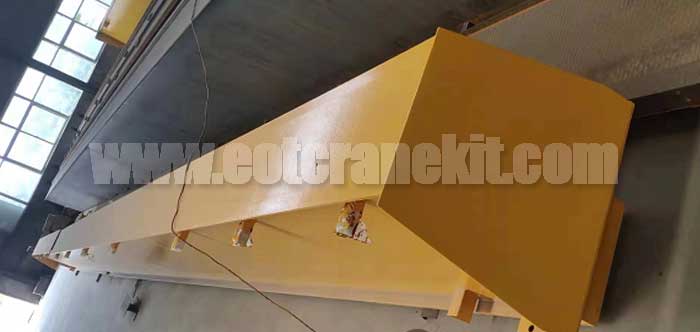
6.3 ton overhead crane kit for sale Philippines, complete single girder top running overhead crane system, low headroom design for workshop indoor use.
Free consultation to Confirm Parameters & Specifications and Get
Latest Crane Price & Crane Rate.
- Types of overhead cranes : _______?
- Optional: Overhead travelling crane, goliath gantry crane,Slewing jib crane, Single girder or double girder crane,small portable crane or kbk crane, etc.
- Capacity of overhead crane: _______?
- Optional: 0.25ton, 0.5 ton, 1 ton, 2 ton, 3ton, 5 ton, 10 ton,15ton, 20ton, 25 ton, 30ton,35ton, up to 550ton, etc.
- Crane span & lifting height : _______?
- Crane travelling length : _____?
- Control of overhead crane:_______?
- Optional: pendant/ remote/cabin control
- Voltage supply of overhead crane:_____?
- Eg,: 380V50/60HZ,3Phase or others,etc.
- Application/usage of crane:_______?
- Eg,: Steel mill, ,injection mold, cement,stone, concrete,granite, general manufacturing, etc.
Just leave a message via the contact form and our hoist and crane engineer will contact you with in 24working hours.
Get In Touch
